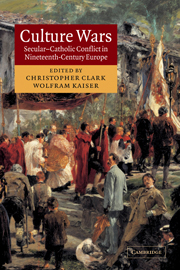Book contents
- Frontmatter
- Contents
- List of illustrations
- List of contributors
- Introduction: The European culture wars
- 1 The New Catholicism and the European culture wars
- 2 ‘Clericalism – that is our enemy!’: European anticlericalism and the culture wars
- 3 ‘Priest hits girl’: on the front line in the ‘war of the two Frances’
- 4 The battle for monasteries, cemeteries and schools: Belgium
- 5 Contested rituals and the battle for public space: the Netherlands
- 6 Nonconformity, clericalism and ‘Englishness’: the United Kingdom
- 7 The assault on the city of the Levites: Spain
- 8 Roma o morte: culture wars in Italy
- 9 Enemies at the gate: the Moabit Klostersturm and the Kulturkampf: Germany
- 10 Village quarrels and national controversies: Switzerland
- 11 The Counter-Reformation's last stand: Austria
- 12 The uncivil origins of civil marriage: Hungary
- Annotated bibliography
- Index
3 - ‘Priest hits girl’: on the front line in the ‘war of the two Frances’
Published online by Cambridge University Press: 23 July 2009
- Frontmatter
- Contents
- List of illustrations
- List of contributors
- Introduction: The European culture wars
- 1 The New Catholicism and the European culture wars
- 2 ‘Clericalism – that is our enemy!’: European anticlericalism and the culture wars
- 3 ‘Priest hits girl’: on the front line in the ‘war of the two Frances’
- 4 The battle for monasteries, cemeteries and schools: Belgium
- 5 Contested rituals and the battle for public space: the Netherlands
- 6 Nonconformity, clericalism and ‘Englishness’: the United Kingdom
- 7 The assault on the city of the Levites: Spain
- 8 Roma o morte: culture wars in Italy
- 9 Enemies at the gate: the Moabit Klostersturm and the Kulturkampf: Germany
- 10 Village quarrels and national controversies: Switzerland
- 11 The Counter-Reformation's last stand: Austria
- 12 The uncivil origins of civil marriage: Hungary
- Annotated bibliography
- Index
Summary
INTRODUCTION
‘Clericalism? That's the enemy!’ Gambetta's battle cry, hurled in a celebrated speech to the Chamber of Deputies on 4 May 1877, has rightly come to be seen as the declaration of war which heralded the onset of the French Kulturkampf, a struggle between the Third Republic and the Catholic church which lasted between 1879 and 1905 and was characterised by the enactment of two major programmes of anticlerical legislation, one between 1879 and the mid-1880s, the other at the turn of the century, the culmination of which was the complete separation of church and state in 1905. The legislative culture war has been studied many times, and will not be re-examined in this chapter. The focus here, rather, is on the culture war on the ground, in order to demonstrate that the culture war was fought not just between a bourgeois intelligentsia (republican and Catholic) in the forum of parliament and the national press but also involved ordinary people, both villagers and priests, in obscure corners of provincial France. The chapter seeks to show further that the late nineteenth-century conflict was only a particular phase – albeit the most decisive one – in a much longer-running guerre des deux Frances, or ‘war of the two Frances’. The French culture war was in many respects a kind of ‘cold'war which periodically irrupted into ‘hot’ war, as in the Breton guerre scolaire (‘battle of the schools’), which provides our case study.
- Type
- Chapter
- Information
- Culture WarsSecular-Catholic Conflict in Nineteenth-Century Europe, pp. 77 - 101Publisher: Cambridge University PressPrint publication year: 2003
- 8
- Cited by



